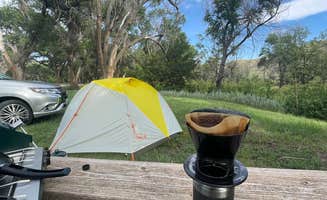Historic Lake Scott State Park spans 1,020 acres in western Kansas at an elevation of 2,970 feet. The park surrounds a 100-acre spring-fed lake with canyon walls rising 100 feet above the water surface. Summer temperatures typically reach 90-100°F during July and August, with cooler evenings in the 60s.
What to do
Fishing opportunities: Timber Canyon Campground provides access to Lake Scott's fishing areas where anglers catch channel catfish, largemouth bass, and rainbow trout. The lake is regularly stocked by the Kansas Department of Wildlife. "Cozy and friendly Beach house workers and Great Fishing and Camping grounds," notes camper Caryn G. who visited Timber Canyon.
Historical sites: Camp near the El Cuartelejo Pueblo ruins, located within park boundaries. This National Historic Landmark contains remains of the northernmost pueblo structure in the United States, dating to the 1600s. The ruins are accessible via a 0.25-mile interpretative trail from the main parking area.
Swimming beach: During summer months, the designated swimming area at Boat Ramp Campsites provides a sandy beach with roped-off swimming zones. The beach area includes picnic tables and grills nearby for day use. No lifeguards are on duty, so swimming is at your own risk.
What campers like
Natural wind protection: The canyon layout at Timber Canyon Campground creates natural shelters for tent camping. "Primitive spaces had a picnic table and fire ring, and you'll likely find a little 'cove' all to yourself," reports Katie L., highlighting the terrain advantages for tent campers seeking protection from Kansas winds.
Covered shelters: Some tent sites include covered structures that provide additional protection during inclement weather. "I stayed for one night on the site with the covered shelter, and it worked out wonderfully because we had a huge lightning storm in the middle of the night," explains Megan C., noting the practical advantage during storms.
Quiet camping areas: Horsethief Campground offers more secluded tent camping than the main campground areas. Sites here are spaced further apart, with fewer RVs, creating a quieter atmosphere for tent campers who prioritize solitude over proximity to facilities.
What you should know
Facility distances: Primitive tent sites at Timber Canyon require longer walks to restrooms. "This particular site would be difficult for family with young children because it is far away from the pit toilet," advises camper Megan C., suggesting families consider site selection carefully based on bathroom proximity.
Limited cell service: Most campgrounds within Historic Lake Scott State Park have spotty cell coverage. Verizon shows the strongest signal, while T-Mobile and AT&T users report limited or no service in canyon areas. Download maps and information before arrival.
Seasonal considerations: Summer weekends (Memorial Day through Labor Day) typically reach capacity. Reservations are strongly recommended for Friday and Saturday nights. Spring and fall camping offers milder temperatures and fewer crowds, with daytime highs in the 70s-80s instead of 90s-100s.
Tips for camping with families
Best family sites: Flatland Campground offers the most family-friendly tent camping sites with shorter walks to modern restroom facilities and showers. These sites have level ground for easier tent setup and are within 100-200 feet of bathrooms.
Wildlife viewing: Morning hours (6-8am) and evening (7-9pm) provide optimal wildlife viewing opportunities. Common sightings include white-tailed deer, wild turkeys, and various bird species. Bring binoculars and wildlife identification guides for children.
Water safety: Lake Scott has several shallow entry points suitable for younger children, but the lake bottom can be muddy. Water shoes are recommended for all swimmers. No designated wading areas exist, so parental supervision is essential.
Tips from RVers
Limited hookup sites: Bullcanyon and primitive areas have no electric or water hookups. Tent campers seeking more amenities should choose Timber Canyon, where "most people seemed to be RV camping in the sites that provided hookups and water," according to Katie L.
Generator restrictions: The park enforces quiet hours from 10pm to 6am when generators cannot be operated. Tent campers should select sites away from RV areas if sensitive to generator noise during daytime hours.
Water fill stations: Potable water is available at centralized locations rather than at individual sites. Campers should bring containers to transport water from fill stations to tent sites, particularly at primitive campgrounds where water sources may be 200+ yards from camping areas.


